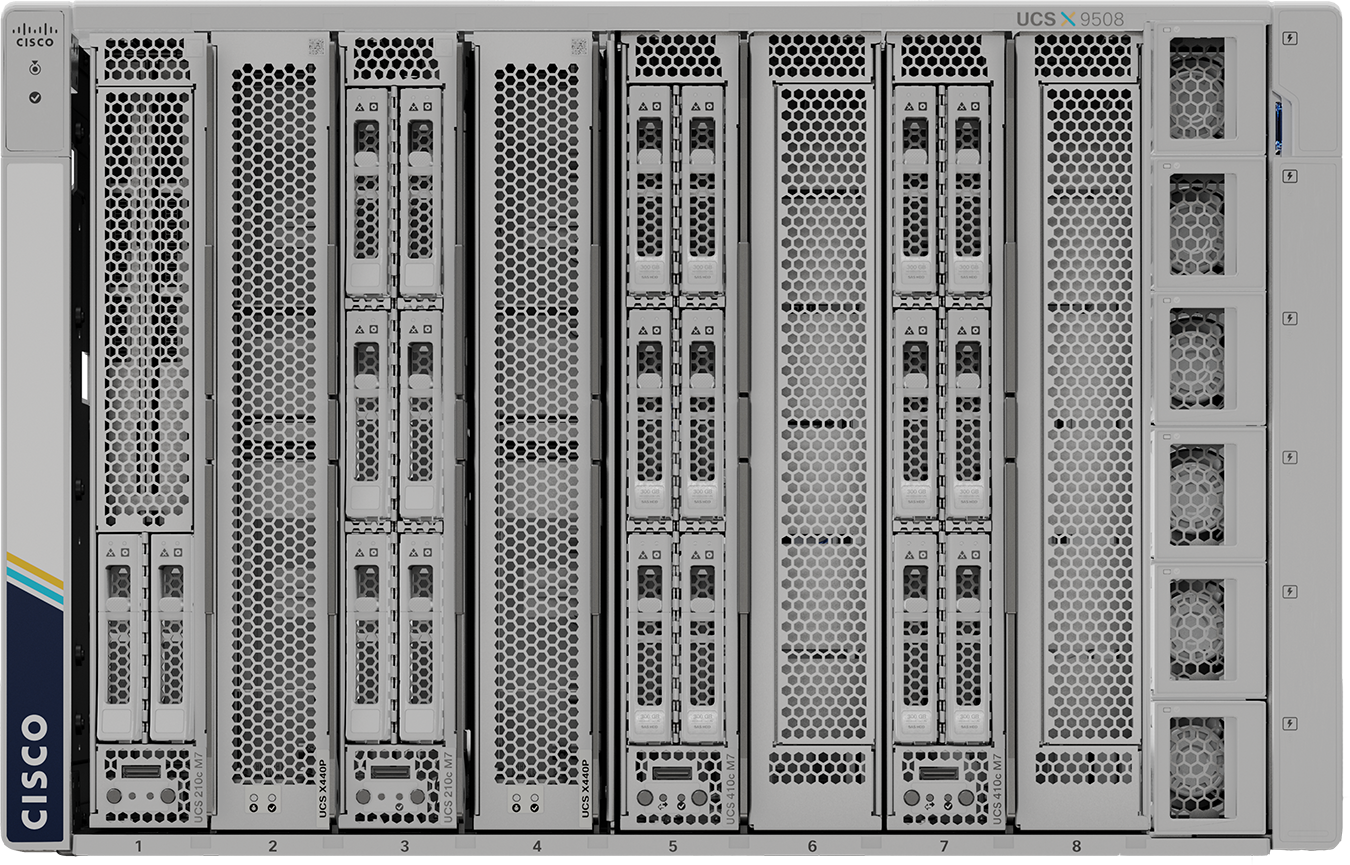Best 4-socket server results with Intel processors
Available Languages
Bias-Free Language
The documentation set for this product strives to use bias-free language. For the purposes of this documentation set, bias-free is defined as language that does not imply discrimination based on age, disability, gender, racial identity, ethnic identity, sexual orientation, socioeconomic status, and intersectionality. Exceptions may be present in the documentation due to language that is hardcoded in the user interfaces of the product software, language used based on RFP documentation, or language that is used by a referenced third-party product. Learn more about how Cisco is using Inclusive Language.
High-end results with the Cisco UCS X410c M7 Compute Node powered by 4th Gen Intel Xeon Scalable Processors
The Cisco UCS X-Series Modular System is ready to serve your data center well into the future with an architecture designed to support many future generations of server, I/O, and networking technologies.
Today we announce that our new 4-socket modular server has captured four top-performance records for 4-socket servers on Intel processors for raw integer and floating-point and high-performance computing performance, and Java enterprise middleware throughput. Powered by up to four 4th Gen Intel® Xeon® Scalable processors, the node is integrated into a system with 100-Gbps networking so that it can take on the most challenging workloads you can offer it.
Prepare for the future with the Cisco UCS X-Series Modular System
With cloud-based lifecycle management through the Cisco Intersight™ IT-operations platform, you can simplify your data center in multiple ways. Simplify with cloud-operated infrastructure that can respond at the speed and scale of your business by shaping resources to workload requirements. Simplify with an adaptable system designed for modern applications—the system can meet the needs of AI and ML software as easily as it supports your enterprise applications. Simplify with a system engineered for the future. Cisco is known for blade server chassis that stand the test of time, and the X-Series is designed to serve your data center well into the future by accommodating new technologies as they arise.
If you want performance from 4th Gen Intel Xeon Scalable processors, choose Cisco UCS
● Top Linux score for integer and floating-point performance
● Top result for Java enterprise middleware performance on Microsoft Windows
● Top result for HPC workloads running on Linux
● Number-two Linux result for Java enterprise middleware
Cisco UCS X-Series Modular System
We can think of several reasons why our solution belongs in your data center:

● Simplify your data center while adapting to the unpredictable needs of modern applications
● Reduce the number of server types, supporting a wider range of workloads with a single platform
● Shift IT focus from administrative details to business outcomes with a platform that is assembled from the cloud, shaped to their workloads, and continuously optimized
● Be ready for the future with a platform that is engineered to adapt to include new technologies as they become available
Top integer and floating-point performance
The top integer and floating-point records for 4th Gen Intel Xeon Scalable processors were set by the Cisco UCS® X410c M7 Compute Node with 32-core Intel Xeon Platinum 6448H processors. We used 2 TB of main memory to achieve these 4-socket server results.
In addition to the power of 4th Gen Intel Xeon Scalable processors, we differentiate our performance through a unique design of hardware and firmware elements. The CPU voltage regulator delivers load-step and load-release current for CPU transients—a feature above and beyond the CPU power requirements. And our thermal design can operate, handle, and sustain peak performance within the thermal operating region. This, combined with BIOS tuning helped us to exceed SPEC CPU® results of other server vendors.
Firmware settings, such as those that control boost frequencies, are set through the Cisco Intersight IT-operations platform, helping you enjoy consistently good performance as a matter of the policies that you establish.
Table 1. Integer and floating-point performance are good predictors of general business application performance
| Benchmark |
Intel Xeon processor |
Cisco UCS server |
Result |
Achievement |
| SPEC CPU® 2017 integer speed |
6448H 32-core |
X410c M7 |
#1 Intel result (tie) running on Linux |
|
| SPEC CPU 2017 floating-point speed |
6448H 32-core |
X410c M7 |
#1 Intel record running on Linux |

This enterprise-class Cisco compute node delivers market-leading performance and density for mission-critical, memory-intensive, bare-metal, and virtualized applications with:
● Four 4th Gen Intel Xeon Scalable Processors
● Up to 16 TB of main memory
● Up to 6 hot-pluggable SSD or NVMe drives with enterprise RAID or passthrough controllers
● Two M.2 SATA drives
● Up to two Cisco® Virtual Interface Cards (VICs) can occupy the server’s modular-LAN-On-Motherboard (mLOM) and mezzanine slots.
● Optional Cisco UCS X440p PCIe Node with up to 4 half-height or 2 full-height GPU accelerators
Java enterprise middleware performance
The SPECjbb®2015 benchmark provides baremetal and virtual performance measurements to give you a more accurate assessment of the way that Java enterprise middleware can perform in your IT environment.
The max-jOPS results reflect the overall throughput that the server can deliver. The critical-jOPS results give a response-time measurement. This result shows the throughput that can be achieved with responses falling into a strict quality-of-service requirement.
Our MultiJVM results are shown in Table 2. These show how well the server can multitask between multiple Java Virtual Machines (JVMs). Our Cisco UCS X410c M7 Compute Node took the number-one result with Intel Xeon processors running Microsoft Windows, and it claimed the number-two result running on Linux.
Table 2. Java enterprise middleware performance as measured by the SPECjbb®2015 MultiJVM benchmark
| Benchmark |
Intel Xeon processor |
Cisco UCS server |
Result |
Achievement |
| SPECjbb®2015 MultiJVM |
8490H 60 core |
X410c M7 |
max-jOPS=684323 |
#1 Intel result on Microsoft Windows |
| SPECjbb2015 MultiJVM |
8490H 60 core |
X410c M7 |
max-jOPS=833070 |
#2 Intel result running on Linux |
SEAL Sustainable Product of the Year Award for 2023

The Cisco UCS X-Series Modular System has achieved sustainable product of the year status as a system that is purpose built for a sustainable future. We designed the X-Series with best-in-class energy efficiency in mind, helping balance performance needs with new sustainability demands on today’s data centers. In a scenario where UCS X-Series is replacing 64 previous-generation servers:
● Customers can use 3.3x less hardware overall, saving precious rack space.
● They can also reduce almost 100,000 kilowatt hours (KwH) of energy, or the equivalent of powering 10 residential homes for a full year.
● The result is that we can help save almost 40 tons of carbon dioxide (tCO2e) emissions.
The SPEComp®G 2012 benchmark measures the performance of high-intensity shared-memory parallel-processing applications. It includes 14 samples from science and engineering environments, including computational fluid dynamics, molecular modeling, and image manipulation. You can use the results for the SPEComp 2012 benchmark to evaluate your own likely performance if you run highly parallelized, CPU-intensive applications. You can also use the energy consumption results as a way to demonstrate your commitment to sustainable computing. Our SPECompG_base2012 result of 84.4 claims the top Intel score running on Linux. We achieved this result with four 60-core Intel Xeon Platinum 8490H processors with 2 TB of main memory.
Table 3. High-performance computing performance as measured by the SPECompG 2012 benchmark
| Benchmark |
Intel Xeon processor |
Cisco UCS server |
Result |
Achievement |
| SPEC OMP® |
8490H 60 core |
X410c M7 |
#1 Intel result running on Linux |
If you are running Intel Xeon Scalable processors in your data center, our newest results demonstrate what you can expect if you upgrade to the newest processors. You can achieve excellent raw integer and floating-point performance, Java enterprise middleware throughput, and high-performance computing applications.